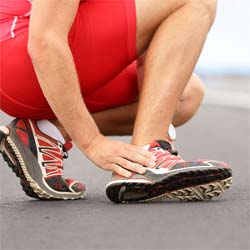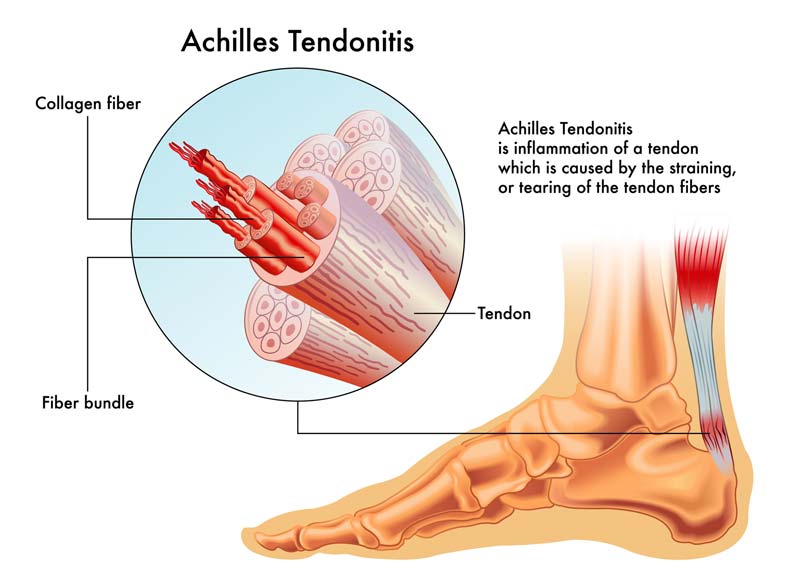Achilles Tendonitis Treatments
January 2019
 The Achilles Tendon is an important structure in your foot that connects the calf muscles (Gastrocnemius and Soleus) and the heel of your foot together. It is the strongest and largest tendon in the body and its primary role is to help with the action of plantar flexion (pointing your toes). The Achilles tendon is highly important in every day movement because it assists with the bodily movements of walking, jumping, “tippy toeing”, and running. Even though the Achilles tendon is the longest and strongest tendon in the body, it is still susceptible to being over used and in some cases, ruptured. If you suspect that you have damaged, have inflamed or have any sorts of pain in your heel area, see a physician that specializes in diagnosing and treating the musculoskeletal system to assure that you are getting the most accurate patient care and treatment.
The Achilles Tendon is an important structure in your foot that connects the calf muscles (Gastrocnemius and Soleus) and the heel of your foot together. It is the strongest and largest tendon in the body and its primary role is to help with the action of plantar flexion (pointing your toes). The Achilles tendon is highly important in every day movement because it assists with the bodily movements of walking, jumping, “tippy toeing”, and running. Even though the Achilles tendon is the longest and strongest tendon in the body, it is still susceptible to being over used and in some cases, ruptured. If you suspect that you have damaged, have inflamed or have any sorts of pain in your heel area, see a physician that specializes in diagnosing and treating the musculoskeletal system to assure that you are getting the most accurate patient care and treatment.
Achilles Tendonitis
When repetitive intense strain is placed on the Achilles tendon, it causes inflammation that results into severe pain when doing sprints, walking up stairs or simply walking. You primarily see this in athletes that have a high involvement of running and athletes that play basketball or tennis due to the high involvement of jumping, pivoting and running.

Achilles Tendonitis Symptoms and Risk Factors
Symptoms of Achilles Tendonitis typically occur after an increased amount of physical activity. Typically after doing heavy amounts of physical activity, pain, tenderness and stiffness usually occurs especially in the morning or after a long time of inactivity. Although these symptoms are minor, they can progress to something more severe. And if left untreated or misdiagnosed, the Achilles tendon may eventually rupture. In addition to neglect of these symptoms, the tendon also weakens the older we get making us more susceptible to injury.
Other than age, other risk factors that play a role is gender, body habitus, medical conditions and current medications. It’s found that men are more susceptible to getting Achilles Tendonitis and individuals that have flat feet and/or obese can put a lot of strain on the tendon increasing their chances of straining the tendon causing inflammation. Also if an individual trains in worn out shoes that lack proper support and padding, it will significantly increase the chances of greater injury and inflammation.
Treatments for Achilles Tendonitis in Los Angeles and Santa Monica
To properly treat Achilles tendonitis, you should see a physician in that specializes in the musculoskeletal system so that they can properly diagnose you and your symptoms as well as create a plan of care for specific to you. Contact our pain management doctor in Los Angeles and Santa Monica to set up a consultation. If it is determined that you have a mild case of Achilles Tendonitis then the best approach would be preventative maintenance which consists of, healthier eating, losing weight, choosing better shoes with more support and comfort and simply just resting it and letting the Achilles heal. Once the Achilles heals and you’re not feeling any of the symptoms, then gradually increase your physical activity because if you don’t, you will put too much stress on it and injury it again, possibly rupture it.
But in the event that you have a more severe case of Achilles Tendonitis, then there are other measures that can be taken to help treat it. One of those treatments is Platelet Rich Plasma (PRP) where a physician takes your own blood that possess growth factors and injects the Achilles tendon where the inflammation is. Platelet Rich Plasma is a relatively new advancement in regenerative therapy that is used to not only help with pain and inflammation but it also helps promote tissue growth and strengthens the tendon which can ultimately prevent surgery. Another treatment for Achilles Tendonitis is Prolotherapy. Prolotherepy is another regenerative therapy that is used to help rebuild the weakened tissues by the use of Dextrose (Sugar water) that inhibits the bodies own inflammation response that causes an influx of blood to rush to the weakened area and start rebuilding collagen. In doing so, it helps relieve pain, tenderness and starts to strengthen the tendon.


